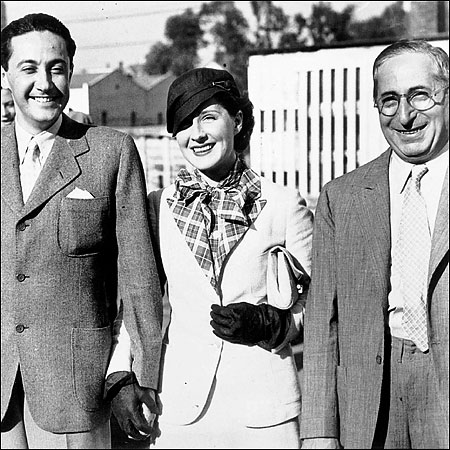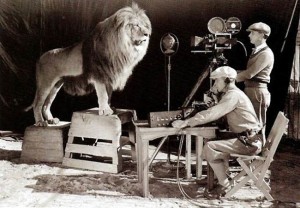As news breaks that MGM has risen out of bankruptcy, this writer would like to take a moment and remember when this studio first entered the news, with its formation being the result of a corporate merger on Wall Street over eighty years ago. Following this merge, Metro-Goldwyn-Mayer would be the dominant motion picture studio in Hollywood, from the end of the silent film era through World War II.
The man behind the merger was Marcus Loew, the owner of a large theater chain known as Loew’s Theatres. Wanting to provide a steady supply of films for his theaters, he had purchased both Metro Pictures Corporation and Goldwyn Pictures. However, both of these companies lacked leadership, and Loew was unable to spare his longtime assistant, Nicholas Schenck, as he was needed in New York City to oversee the theater chain. The answer came to Loew when his visited the studio of Louis B. Mayer Pictures, where he witnessed the studio head and his young producing partner running the type of operation he was looking for. Louis B. Mayer Pictures was purchased on April 16, 1924, and thus the resources from three studios were pulled together to make one of the biggest success stories in all of Hollywood history.
Metro Pictures Corporation
Metro Pictures Corporation was a production company founded in 1915 by Richard A. Rowland, and had begun producing their own films in 1918, with production on the east and west coast. Loew had purchased the company, hoping it would keep his theaters supplied with films, but the company was unable to keep up with the demand. Part of the reason for this was that the facility was more executive offices than stages, not leaving a lot of room for production. Another reason was that the abrupt resignation and departure of Rowland left the management team in a state of disarray. However, Metro did offer a small stable of talent, including Alice Lake and Ramon Novarro, as well as having an excellent distribution system in place through Loew’s Theatres.
Samuel Goldwyn Productions
Goldwyn Pictures Corporation was founded in 1916 by Samuel Goldfish (who eventually changed his name to Samuel Goldwyn to capitalize on the name brand value) in partnership with Broadway producers Archibald and Edgar Selwyn. The company name was created using an amalgamation of both last names to create the name. Goldfish was eventually forced out of the company by his partners.
In 1916, Howard Dietz created the Goldwyn logo, featuring “Leo the Lion” and the Latin motto “Ars Gratia Artis” meaning “Art for art’s sake.” Dietz, being an alum of Colunbia University, based the lion design on his alma mater’s mascot.
Samuel Goldwyn Productions brought the most to the merger in terms of assets, totaling about $4.7 million. Among these assets were a forty-six acre facility, with dozens of outdoor sets, six stages, offices, dressing rooms, editing rooms, screening rooms, carpentry shops, and a restaurant. In terms of talent, they brought John Gilbert, Conrad Nagel, and William Haines.
Louis Mayer Productions
Offering the least in terms of assets was Louis Mayer Productions. Located outside of Hollywood in a remote portion of Los Angeles, the studio was so small, that the property lot was actually shared with a zoo. However, what they lacked in size, they made up for in quality.
The driving force behind this production was Louis Mayer, the studio head, and Irving Thalberg, the head of production. Thalberg had gotten his start at Universal Pictures, at which he earned the nickname “Boy Wonder” for his ability to organize and manage productions. Having been grown tired of Universal owner Carl Laemmle, Thalberg joined Mayer in the formation of his smaller studio. They were able to establish an impressive group of talent, including directors John Stahl and Fred Niblo, and actresses Norma Shearer and Anita Stewart. However, despite putting out quality films, the studio was often in a dire financial position, as they did not have the space or staff to maximize their potential.
Louis Mayer had actually been a secretary at Metro Pictures for a while, and had maintained a friendship with Metro’s attorney, J. Robert Rubin. It was through Rubin that Mayer knew that Loew was looking for a fix to his production problem, so he was all too happy to give Loew a tour of his well run operation. Loew quickly saw the solution to his management problem, and set the wheels in motion for his merger.
Formation
Meetings began January 1924. Loew bought out both the Goldwyn Company and Louis Mayer’s company, buying out Sam Goldwyn’s stock as well to ensure getting clear titles. He also dissolved Metro, maintaining its established system of distribution. In the end, he had Metro’s distribution, Goldwyn’s studio, and Mayer’s management.
In a press release, Marcus Loew stated:
“The motion-picture business is going through a stabilizing process and is working itself out on sane, economic principles. Through combining our forces in the best interest of all parties to the merger, Metro, Goldwyn, [and] the Louis Mayer Company are going a long way in the right direction. In order to obtain the greatest efficiency and economy in production such a step was inevitable… The merger will accomplish mutual savings that will react to the benefit of the exhibitor, and through the exhibitor to the public, which is what we wish to bring about.”
After making such an investment (the New York Times reported the investment to be worth sixty-five million dollars), Loew felt entitled to make his son, Arthur Loew, the head of production at his new studio. However, Mayer remained firm on insisting that Thalberg remain the production head. He was aware of what the boy was capable of, and wanted to see that potential put into action.
After the Merger
Originally, the studio only featured the names Metro-Goldwyn, with the studio’s new films being presented as “Louis B. Mayer presents a Metro-Goldwyn picture.” However, by 1925, Mayer was able to add his name to the studio with Loew’s blessing, so it would be forever known as Metro-Goldwyn-Mayer, or MGM for short.
Within it’s first year, MGM would have huge success with its films The Big Parade and Ben-Hur. With these box office successes, along well managed production team, MGM was able to surpass Universal as the largest studio in Hollywood, and would manage to maintain this status for over thirty years.
Sadly, its founder would not live to see much of this, as Marcus died three years after the merger. Control of Loew’s was passed to his assistant Nicholas Schenck, who would have a notoriously rocky relationship with Louis Mayer for the decades to follow.
With the formation of the new studio also came the updated version of the company logo. Howard Dietz updated his original lion design, and remained the studio’s chief publicist. He would also coin a second motto for the company, as the growing number of talent in the stock company led MGM to boast that it had “more stars than there are in heaven.”
It was quite fitting that Mayer and his crew would have such a mascot, as in the days that his studio shared the lot with a zoo, the roar of lions could be heard on the studio stages (they were silent films, so this wasn’t a problem). Actress Norma Shearer would comment that she could hear these roars from her dressing room, and they would summon strength in her for her performances. From the new studio, she could see the brightly lit sign above the studio, and it continued to be a symbol of courage.
Audiences have seen many versions of Leo over the years, with the lion first appearing in the 1924 intros. However, this lion was silent, and it wasn’t until 1928 that audiences got to hear his roar for the first time. As the MGM arises from its dire financial state, one can only hope that it is on the path of rebuilding and reclaiming the glory this great studio once had, and that lion will continue to roar for decades to come.


